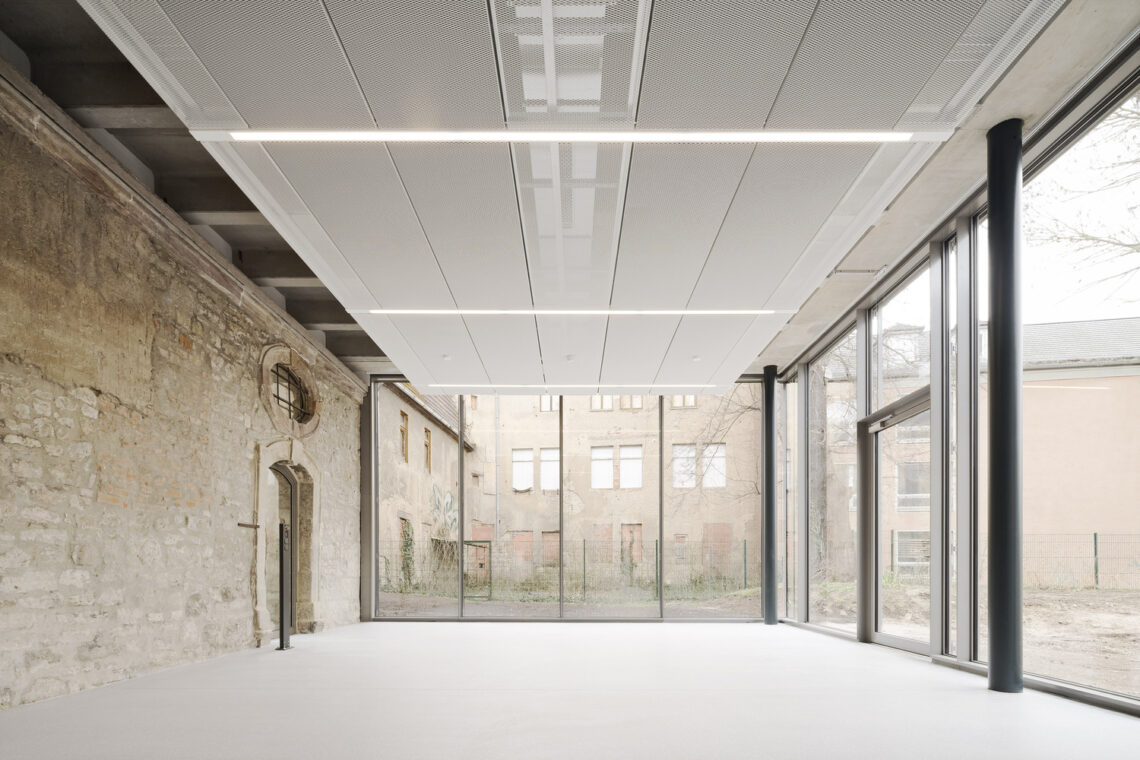Architects: Muffler Architekten PartG mbB
Area: 2,640 m²
Year: 2023
Photographs: Brigida Gonzales
Manufacturers: Colt, Franz Nüsing GmbH & Co. KG, Freese Fußbodentechnik, M.C.I. Metalldecken, SANA Trennwandbau, Schmitt + Sohn Aufzüge, Woschko Winlite, Zumtobel
Electrical Planning: IEB Ingenieurbüro für Haustechnik
HVAC Planning: IEB Ingenieurbüro für Haustechnik
Design / Project Management: Michael Muffler, Tano Muffler
Project Management: Reiner Glocker
Program / Use / Building Function: Museum
City: Weimar
Country: Germany
The Bauhaus Museum, designed by Muffler Architekten in Weimar, has revitalized the historic former carriage depot at Theaterplatz 4. Completed between 2017 and 2023, this museum preserves the building’s original symmetry while integrating modern interventions. Serving as the centerpiece of Zeughofquartier, the museum links the historic armory ruins with its new extension. The project includes spaces for political education, exhibitions, and scientific research, all designed with sustainable materials and a clear, elegant aesthetic.

Historical events shape identity, and this is true for the building at Theaterplatz 4. Located directly across from the significant Weimar National Theatre, it plays a crucial role in the city’s narrative. This heritage-listed former carriage depot (1823) stands as a witness to a diverse history. Like the city itself, the building has undergone numerous architectural transformations. Its most recent incarnation as an art gallery, known as the “Bauhaus Museum,” strategically aligns with Theaterplatz, showcasing its grand facade. While alterations to the side annexes have somewhat obscured the original symmetrical concept, the art gallery’s expansive exhibition space emerges clearly from its original symmetry. The building’s connection to the square is well-defined and architecturally significant, this precision is lost in the rear portion.


The neighborhood is transforming with the design of the “House of the Weimar Republic.” The museum aims to bestow a distinctive identity upon the Zeughofquartier, serving as its prominent and prestigious centerpiece. The ruin of the former armory, closely linked to the House of the Weimar Republic, plays a vital role in this transformation. The preserved outer walls of the armory’s base intersect with the structure of the art gallery, providing a tangible link between the histories of both buildings, contributing to their shared identity, and offering an opportunity to revitalize the rear area of the existing art gallery.


The design follows a clear concept: enhancing the existing through minimal interventions. The foyer, museum shop, and cloakroom serve as an introduction to the building, granting access to the expansive hall of the art gallery. This space houses the initial section of the exhibition and is flexible enough to accommodate events or special exhibitions. The portal of the hall is mirrored on its rear wall, creating a seamless transition to the extension. The new structure interacts with the existing, maintaining a respectful distance rather than engulfing it. A lightweight circulation element is a connecting element between the existing and new building, seamlessly integrating all levels of the House of the Weimar Republic at their vertical intersection, this design provides a direct experiential connection with the armory ruins.


The museum’s extension is built upon the foundation of the armory ruins, consisting of three distinct yet purposeful spaces. The garden level encompasses areas of political education, housing a multifunctional room, and a small café. With its transparent design and openness on all sides, this space fosters a connection with the surroundings. The interior is minimally partitioned, with a focus on the historic base walls of the armory. The middle level continues the exhibition space, providing flexibility through movable partitions or inserted structures. This neutral space emphasizes the museal presentation, while strategically positioned windows offer direct views of the open area. The upper level is a hub for scientific research, accommodating offices, meeting areas, and a library within a flexible framework. A continuous band of windows ensures ample natural light and establishes a connection with the outside environment. The basement remains mostly unchanged, serving as storage and technical areas, while the public restrooms will be renovated to align with the overall design.


The design aims to exude a sense of tranquility and presence. The extension seamlessly continues the narrative of the art gallery, breathing new life into its identity. To achieve this, a homogeneous structure will be added to the existing heterogeneous building, embodying a classic elegance. A simple and raw reinforced concrete framework provides the foundation, while the ground floor seamlessly blends interior and exterior spaces, accentuating the historic walls of the armory. The solid structure above appears to float, with windows thoughtfully integrated to serve their purpose. The interior spaces feature understated surfaces and sustainable materials, creating simple, plastered rooms. To highlight a unified effect, the museum’s extension will be clad in a dress-like facade. White rounded tubes adorn the exterior, symbolizing an expansion of functions while retaining the existing structure as a backdrop.

Project Gallery




































Project Location
Address: Theaterplatz 4, 99423 Weimar, Germany
Location is for general reference and may represent a city or country, not necessarily a precise address.


